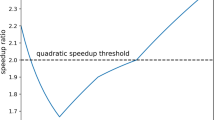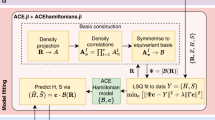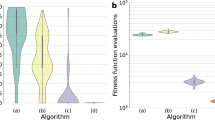Abstract
Modern condensed-matter theory from first principles is highly successful when applied to materials of given structure-type or restricted unit-cell size. But this approach is limited where large cells or searches over millions of structure types become necessary. To treat these with first-principles accuracy, one 'coarse-grains' the many-particle Schrödinger equation into 'model hamiltonians'1,2,3 whose variables are configurational order parameters (atomic positions, spin and so on), connected by a few 'interaction parameters' obtained from a microscopic theory3,4. But to construct a truly quantitative model hamiltonian, one must know just which types of interaction parameters to use, from possibly 106–108 alternative selections. Here we show how genetic algorithms5, mimicking biological evolution ('survival of the fittest'), can be used to distil reliable model hamiltonian parameters from a database of first-principles calculations. We demonstrate this for a classic dilemma6 in solid-state physics7, structural inorganic chemistry8 and metallurgy9: how to predict the stable crystal structure of a compound given only its composition. The selection of leading parameters based on a genetic algorithm is general and easily applied to construct any other type of complex model hamiltonian from direct quantum-mechanical results.
This is a preview of subscription content, access via your institution
Access options
Subscribe to this journal
Receive 12 print issues and online access
$259.00 per year
only $21.58 per issue
Buy this article
- Purchase on Springer Link
- Instant access to full article PDF
Prices may be subject to local taxes which are calculated during checkout




Similar content being viewed by others
References
Landau, L. D. & Lifshitz, E. M. Statistical Physics (Pergamon, Oxford, 1980). Transl. from the Russian by J. B. Sykes & M. J. Kearsley.
Rado, G. T. & Suhl, H. (eds) Magnetism Vol. 2B (Academic, New York, 1965).
Zunger, A. In Statics and Dynamics of Alloy Phase Transformations (eds Turchi, P. & Gonis, A.) 361–419 (Plenum, New York, 1994).
de Fontaine, D. Cluster approach to order-disorder transformations in alloys. Solid State Phys. 47, 33–176 (1994).
Michalewicz, Z. & Fogel, D. B. How to Solve it: Modern Heuristics (Springer, Berlin, 2000).
Maddox, J. Crystals from first principles. Nature 335, 201 (1988).
Phillips, J. C. Bonds and Bands in Semiconductors (Academic, New York, 1973).
Pauling, L. The Nature of the Chemical Bond (Cornell Univ. Press, Ithaca, 1960).
Hume-Rothery, W. & Raynor, G. The Structure of Metals and Alloys (Institute of Metals, London, 1954).
Connolly, J. & Williams, A. Density-functional theory applied to phase transformations in transition-metal alloys. Phys. Rev. B 27, 5169–5172 (1983).
Kikuchi, R. In Noble Metal Alloys (eds Massalski, T. B., Pearson, W. B., Bennet, L. H. & Chang, Y. A.) (The Metallurgical Society, Warrendale, PA, 1986).
van der Walle, A. & Ceder, G. Automating first-principles phase diagram calculations. J. Phase Equil. 23, 348–359 (2002).
Zarkevich, N. A. & Johnson, D. D. Reliable first-principles alloy thermodynamics via truncated cluster expansions. Phys. Rev. Lett. 92, 255702 (2004).
de Gironcoli, S. & Baroni, S. Effects of disorder on the vibrational properties of SiGe alloys: failure of mean-field approximations. Phys. Rev. Lett. 69, 1959–1962 (1992).
Deaven, D. M. & Ho, K. M. Molecular geometry optimization with a genetic algorithm. Phys. Rev. Lett. 75, 288–291 (1995).
Ho, K. M. et al. Structures of medium-sized silicon clusters. Nature 392, 582 (1998).
Stucke, D. P. & Crespi, V. H. Predictions of new crystalline states for assemblies of nanoparticles: perovskite analogues and 3-D arrays of self-assembled nanowires. Nano Lett. 3, 1183–1186 (2003).
Morris, J. R., Deaven, D. M. & Ho, K. M. Genetic algorithm energy minimization for point charges on a sphere. Phys. Rev. B 53, R1740 (1996).
Johannesson, G. H. et al. Combined electronic structure and evolutionary search approach to materials design. Phys. Rev. Lett. 88, 255506 (2002).
Klimeck, G. & Bowen, R. C. Si tight-binding parameters from genetic algorithm fitting. Superlattices Microstruct. 27, 77–88 (2000).
Blum, V. & Zunger, A. Structural complexity in binary bcc ground states: the case of bcc MoTa. Phys. Rev. B 69, 020301 (2004).
Predel, B. (ed.) Phase Equilibria, Crystallographic and Thermodynamic Data of Binary Alloys. Landolt-Börstein, New Series, Group IV Vol. 5H (Springer, Berlin, 1997).
Sigli, C. & Sanchez, J. M. Electronic Structure calculation of ordering and segregation energies of transition metal alloys. Acta Metall. Mater. 36, 367–375 (1988).
Turchi, P. E. A., Gonis, A., Drchal, V. & Kurdnovsky, J. First-principles study of stability and local order in substitutional Ta–W alloys. Phys. Rev. B 64, 085112 (2001).
Baumann, K. Cross validation as the objective function for variable selection. Trends Anal. Chem. 22, 395–406 (2003).
Kresse, G. & Furthmüller, J. Efficiency of ab-initio total energy calculations for metals and semiconductors using a plane-wave basis set. Comput. Mater. Sci. 6, 15–50 (1996).
Acknowledgements
We acknowledge financial support from the NSF through DMR-0244183, and from DOE-SC-BES-DMS, as well as the Intramural Grant Program at Northern Arizona University.
Author information
Authors and Affiliations
Corresponding author
Ethics declarations
Competing interests
The authors declare no competing financial interests.
Rights and permissions
About this article
Cite this article
Hart, G., Blum, V., Walorski, M. et al. Evolutionary approach for determining first-principles hamiltonians. Nature Mater 4, 391–394 (2005). https://doi.org/10.1038/nmat1374
Received:
Accepted:
Published:
Issue Date:
DOI: https://doi.org/10.1038/nmat1374
This article is cited by
-
Inverse Hamiltonian design by automatic differentiation
Communications Physics (2023)
-
Genetic-tunneling driven energy optimizer for spin systems
Communications Physics (2023)
-
Effects of Aluminum and Molybdenum on the Phase Stability of Iron-Chromium Alloys: A First-Principles Study
JOM (2023)
-
A Neural Network Driven Approach for Characterizing the Interplay Between Short Range Ordering and Enthalpy of Mixing of Binary Subsystems in the NbTiVZr High Entropy Alloy
Journal of Phase Equilibria and Diffusion (2023)
-
Approaches for handling high-dimensional cluster expansions of ionic systems
npj Computational Materials (2022)



